A Heuristic Approach for Inter-Facility Comparison of Results from Round Robin Testing of a Floating Wind Turbine in Irregular Waves
Abstract
:1. Introduction
2. Wind Round Robin Test Campaign
3. Responses in Irregular Waves
4. Metrics
- 1.
- calculated over the wave frequency range divided by the targeted value.
- 2.
- calculated over the wave frequency range divided by the targeted value.
- 3.
- calculated over the wave frequency range divided by the targeted value.
- 4.
- , the square root of integral of a response over the wave frequency range divided by .
- 5.
- , the period associated with the resonance peak of the response.
Application of the Metrics to Tests with JONSWAP = 1.29 s = 5 cm
5. Results
5.1. Effect of Wave Seed on Responses
5.2. Effect of on the Metrics
5.3. Effect of Thrust on Responses in JONSWAP Waves with = 1.29 s and = 1.81 s
5.4. Effect of Thrust on Responses in JONSWAP Waves with = 2.58 s
5.5. Effect of Thrust on Responses in the Pink-Noise Waves
6. Discussion
6.1. Advantages of Using Metrics
6.2. Limitations of Metrics
7. Conclusions
Author Contributions
Funding
Data Availability Statement
Acknowledgments
Conflicts of Interest
Abbreviations
| CoG | Centre of Gravity |
| DoF | Degree of Freedom |
| FOWT | Floating Offshore Wind Turbine |
| ITTC | International Towing Tank Conference |
| JONSWAP | Joint North Sea Wave Project |
| LF | Low Frequency |
| MoI | Moment of Inertia |
| ORE | Offshore Renewable Energy |
| PSD | Power Spectral Density |
| RAO | Response Amplitude Operator |
| WF | Wave Frequency |
| 1 | www.marinet2.eu (accessed on 17 September 2021). |
| 2 | Register of ITTC guidelines is available at https://www.ittc.info/media/4251/register.pdf (accessed on 17 September 2021). |
References
- Gueydon, S.; Bayati, I.; de Ridder, E.J. Discussion of solutions for basin model tests of FOWTs in combined waves and wind. Ocean. Eng. 2020, 209, 107288. [Google Scholar] [CrossRef]
- Noble, D.R.; O’Shea, M.; Judge, F.; Robles, E.; Martinez, R.; Khalid, F.; Thies, P.R.; Johanning, L.; Corlay, Y.; Gabl, R.; et al. Standardising Marine Renewable Energy Testing: Gap Analysis and Recommendations for Development of Standards. J. Mar. Sci. Eng. 2021, 9, 971. [Google Scholar] [CrossRef]
- Noble, D.R.; Draycott, S.; Ordonez Sanchez, S.; Porter, K.; Johnstone, C.; Finch, S.; Judge, F.; Desmond, C.; Santos Varela, B.; Lopez Mendia, J.; et al. D2.1 Test Recommendations and Gap Analysis Report; Technical Report, MaRINET2; 2018. Available online: https://www.marinet2.eu/project-reports-2/ (accessed on 7 June 2021).
- Ohana, J.; Gueydon, S.; Judge, F.; Haquin, S.; Weber, M.; Lyden, E.; Thiebaut, F.; O’Shea, M.; Murphy, J.; Davey, T.; et al. Round robin tests on a hinged raft wave energy converter. J. Mar. Sci. Eng. 2021, 9, 946. [Google Scholar]
- Judge, F.M.; Lyden, E.; O’Shea, M.; Flannery, B.; Murphy, J. Uncertainty in Wave Basin Testing of a Fixed Oscillating Water Column Wave Energy Converter. Asce-Asme Risk Uncert Engrg. Sys. Part Mech. Engrg. 2021, 7, 040902. [Google Scholar] [CrossRef]
- Davey, T.; Sarmiento, J.; Ohana, J.; Thiebaut, F.; Haquin, S.; Weber, M.; Gueydon, S.; Judge, F.; Lyden, E.; O’Shea, M.; et al. Round Robin Testing: Exploring Experimental Uncertainties through a Multifacility Comparison of a Hinged Raft Wave Energy Converter. J. Mar. Sci. Eng. 2021, 9, 946. [Google Scholar] [CrossRef]
- Gueydon, S.; Judge, F.M.; O’Shea, M.; Lyden, E.; Le Boulluec, M.; Caverne, J.; Ohana, J.; Kim, S.; Bouscasse, B.; Thiebaut, F.; et al. Round Robin Laboratory Testing of a Scaled 10 MW Floating Horizontal Axis Wind Turbine. J. Mar. Sci. Eng. 2021, 9, 988. [Google Scholar] [CrossRef]
- Remery, G.F.M.; Hermans, A.J. The slow drift oscillations of a moored object in random seas. Soc. Pet. Eng. J. 1972, 12, 191–198. [Google Scholar] [CrossRef]
- Li, Y.; Tang, Y.; Zhu, Q.; Qu, X.; Wang, B.; Zhang, R. Effects of second-order wave forces and aerodynamic forces on dynamic responses of a TLP-type floating offshore wind turbine considering the set-down motion. J. Renew. Sustain. Energy 2017, 9, 63302. [Google Scholar] [CrossRef]
- Raach, S.; Schlipf, D.; Sandner, F.; Matha, D.; Cheng, P.W. Nonlinear model predictive control of floating wind turbines with individual pitch control. In Proceedings of the 2014 American Control Conference, Portland, OR, USA, 4–6 June 2014; pp. 4434–4439. [Google Scholar] [CrossRef]
- Goda, Y. Random Seas and Design of Maritime Structures; World Scientific: Singapore, 2010; Volume 33, p. 732. [Google Scholar] [CrossRef]
- Brodtkorb, P.A.; Johannesson, P.; Lindgren, G.; Rychlik, I.; Rydén, J.; Sjö, E. WAFO-a Matlab toolbox for analysis of random waves and loads. In Proceedings of the 10th International Offshore and Polar Engineering Conference, Seattle, WA, USA, 28 May–2 June 2000. [Google Scholar]
- Pinkster, J.A. Low Frequency Second Order Wave Exciting Forces on Floating Structures. Ph.D. Thesis, Delft University of Technology, Delft, The Netherlands, 1980. [Google Scholar]
- Coulling, A.J.; Goupee, A.J.; Robertson, A.N.; Jonkman, J.M. Importance of second-order difference-frequency wave-diffraction forces in the validation of a fast semi-submersible floating wind turbine model. In Proceedings of the International Conference on Offshore Mechanics and Arctic Engineering, Nantes, France, 9–14 June 2013; American Society of Mechanical Engineers: New York, NY, USA, 2013; Volume 55423, p. V008T09A019. [Google Scholar]
- Gueydon, S.; Duarte, T.; Jonkman, J. Comparison of second-order loads on a semisubmersible floating wind turbine. In Proceedings of the International Conference on Offshore Mechanics and Arctic Engineering, San Francisco, CA, USA, 8–13 August 2014; American Society of Mechanical Engineers: New York, NY, USA, 2014; Volume 45530, p. V09AT09A024. [Google Scholar]
- Robertson, A.N.; Gueydon, S.; Bachynski, E.; Wang, L.; Jonkman, J.; Alarcón, D.; Amet, E.; Beardsell, A.; Bonnet, P.; Boudet, B.; et al. OC6 Phase I: Investigating the underprediction of low-frequency hydrodynamic loads and responses of a floating wind turbine. J. Phys. Conf. Ser. 2020, 1618, 32033. [Google Scholar] [CrossRef]
- Gueydon, S.; Lyden, E.; Judge, F.; Michael, O. MaRINET 2 Floating Offshore Wind Turbine Test Data Set–UCC; SEANOE, 2021. Available online: 10.17882/83063 (accessed on 17 September 2021).
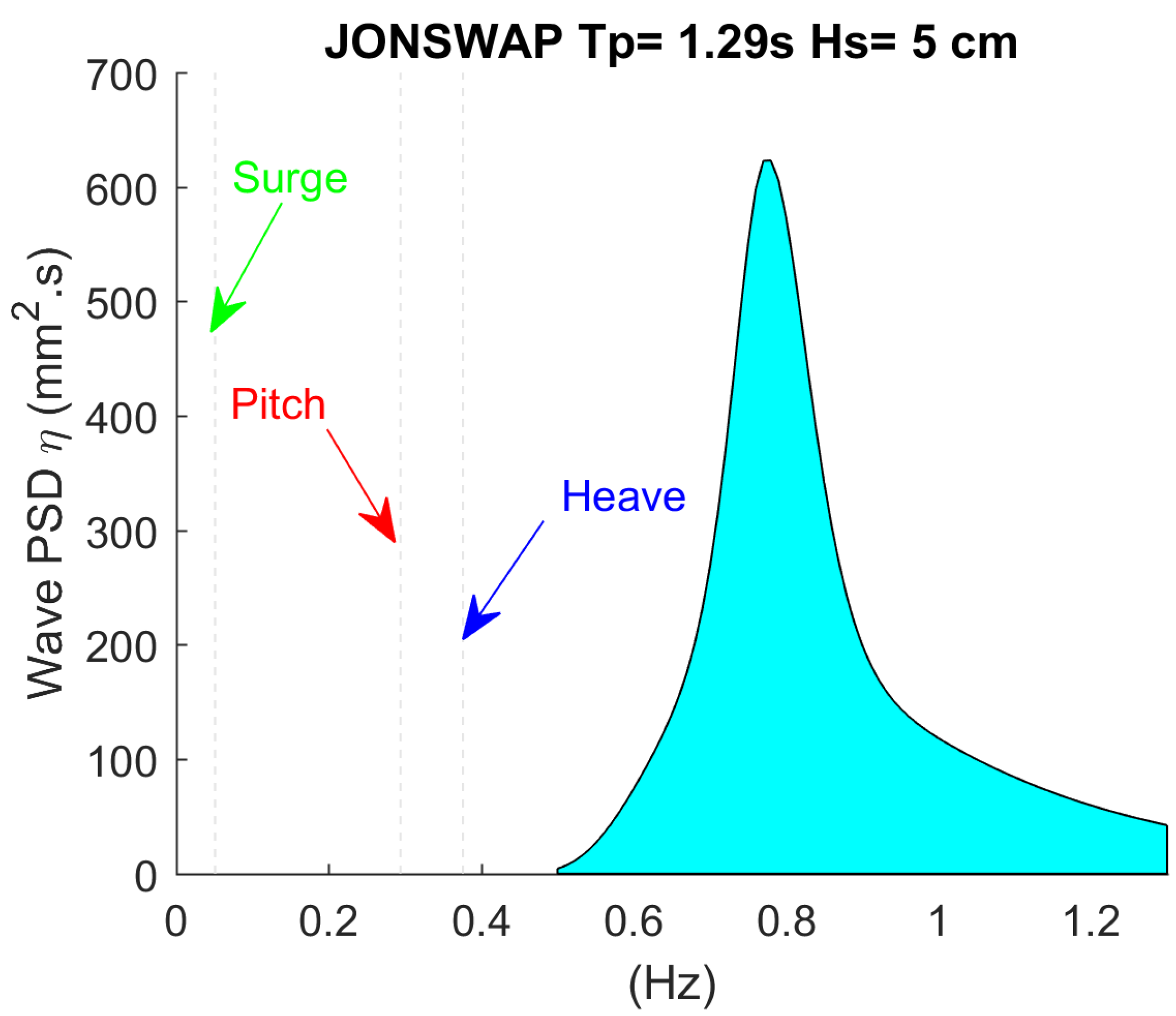
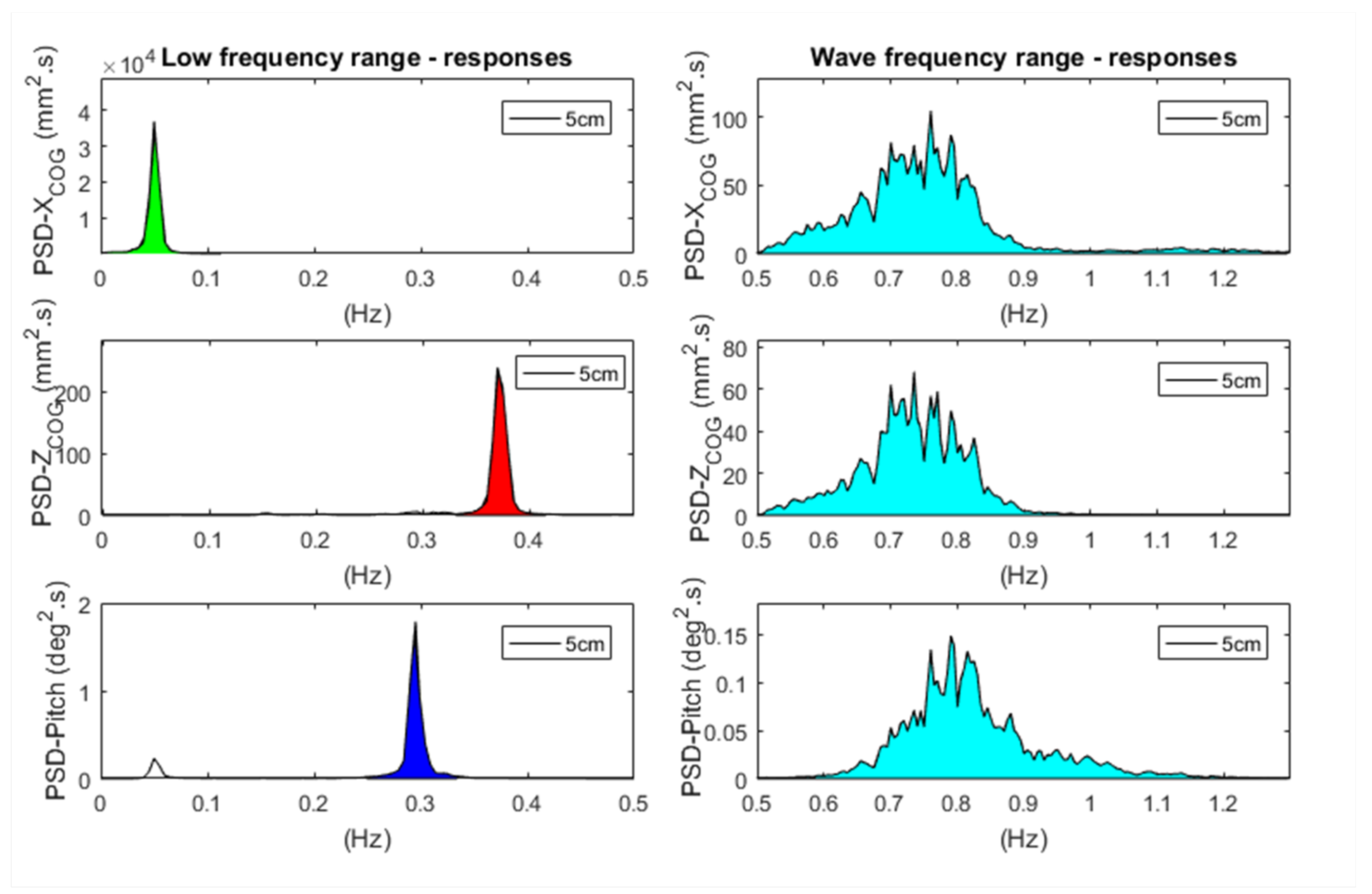
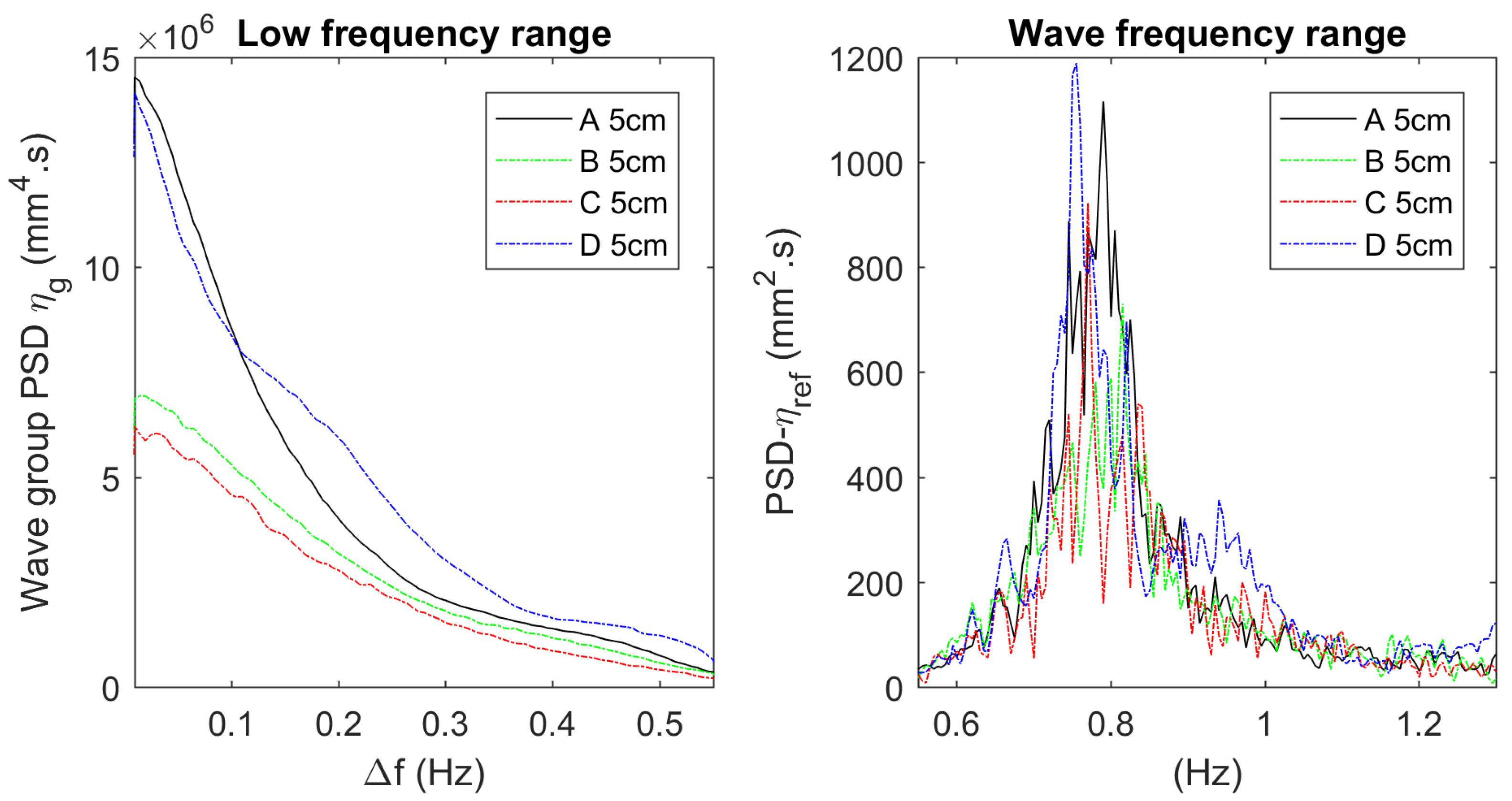
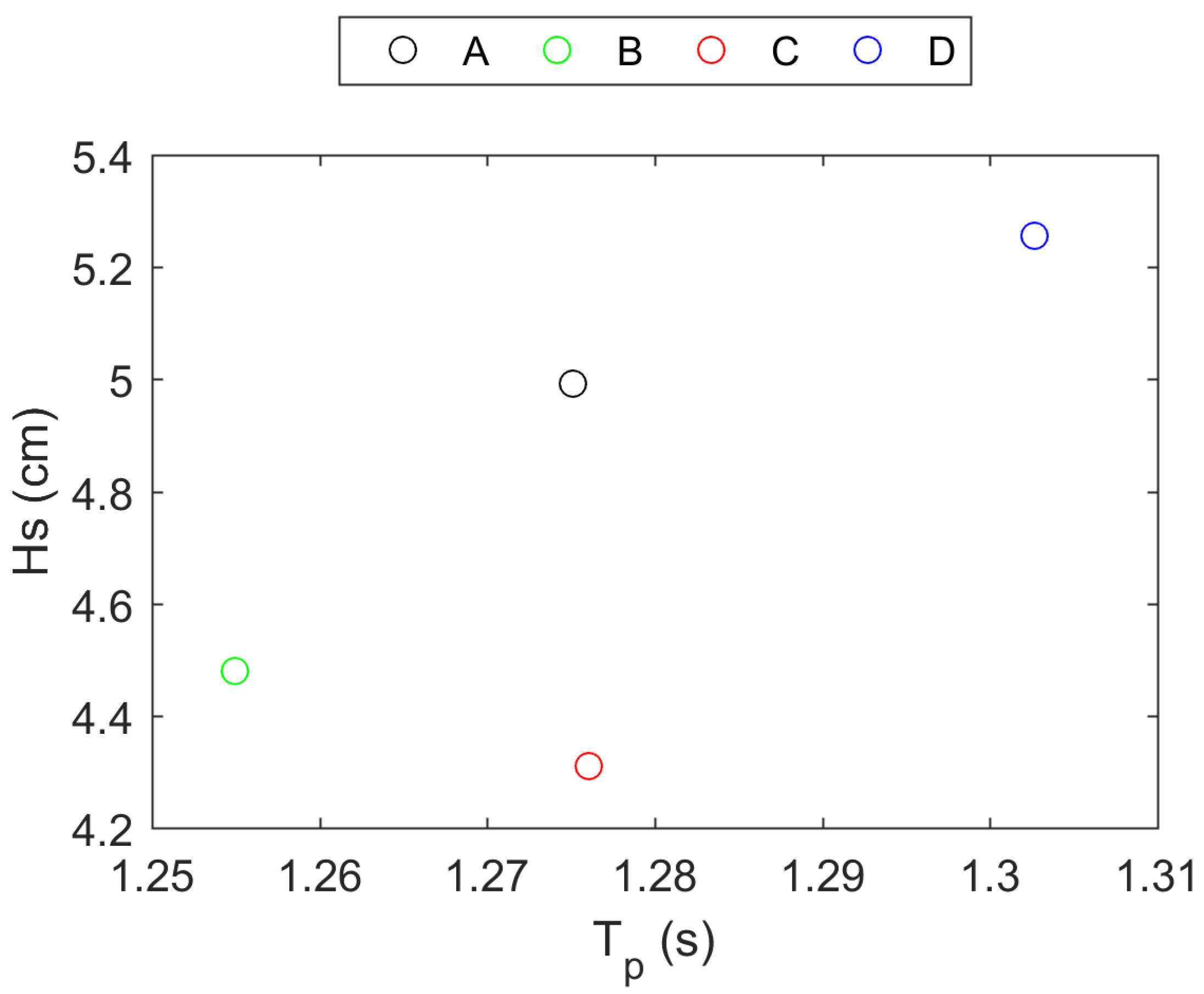



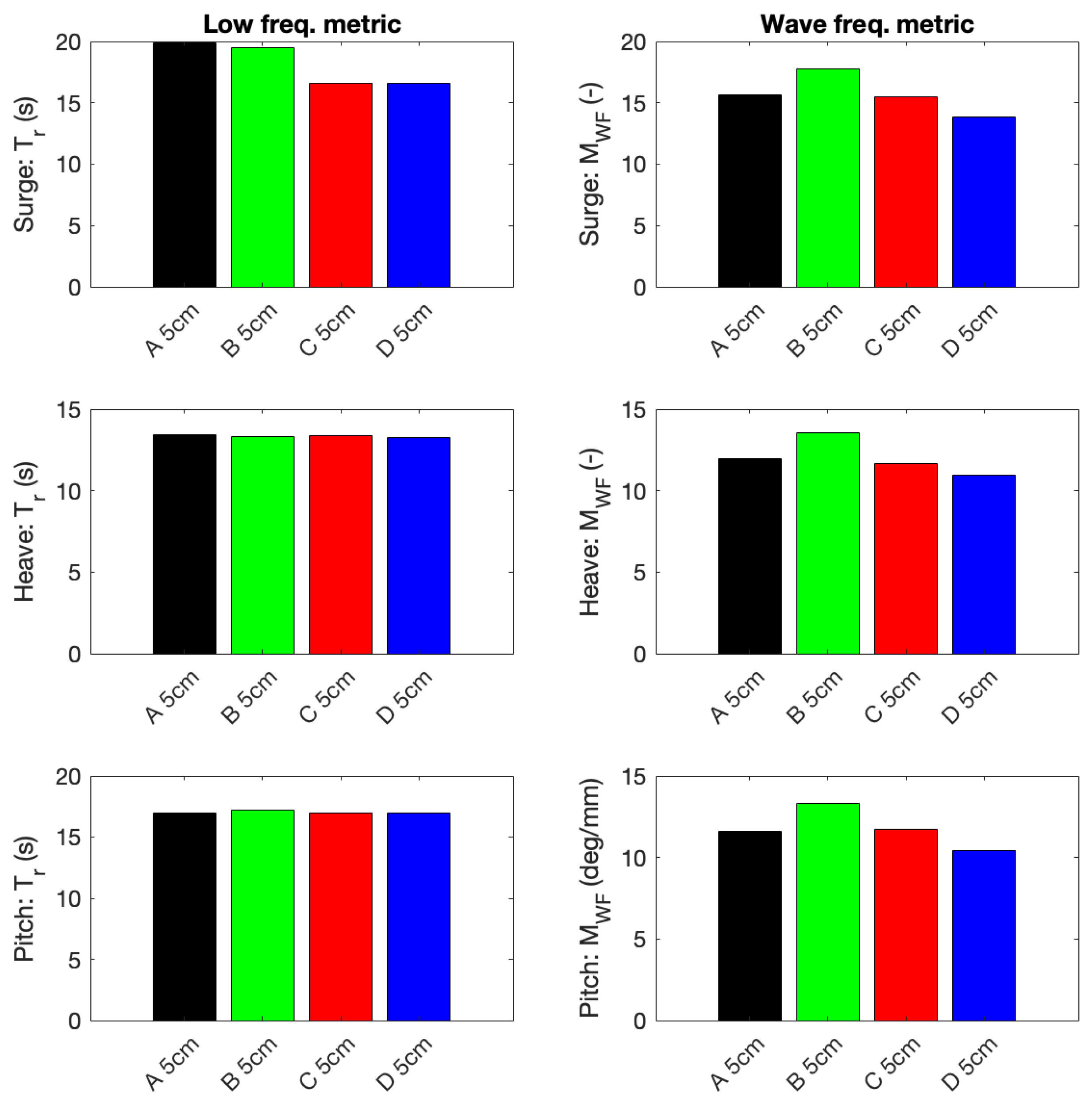

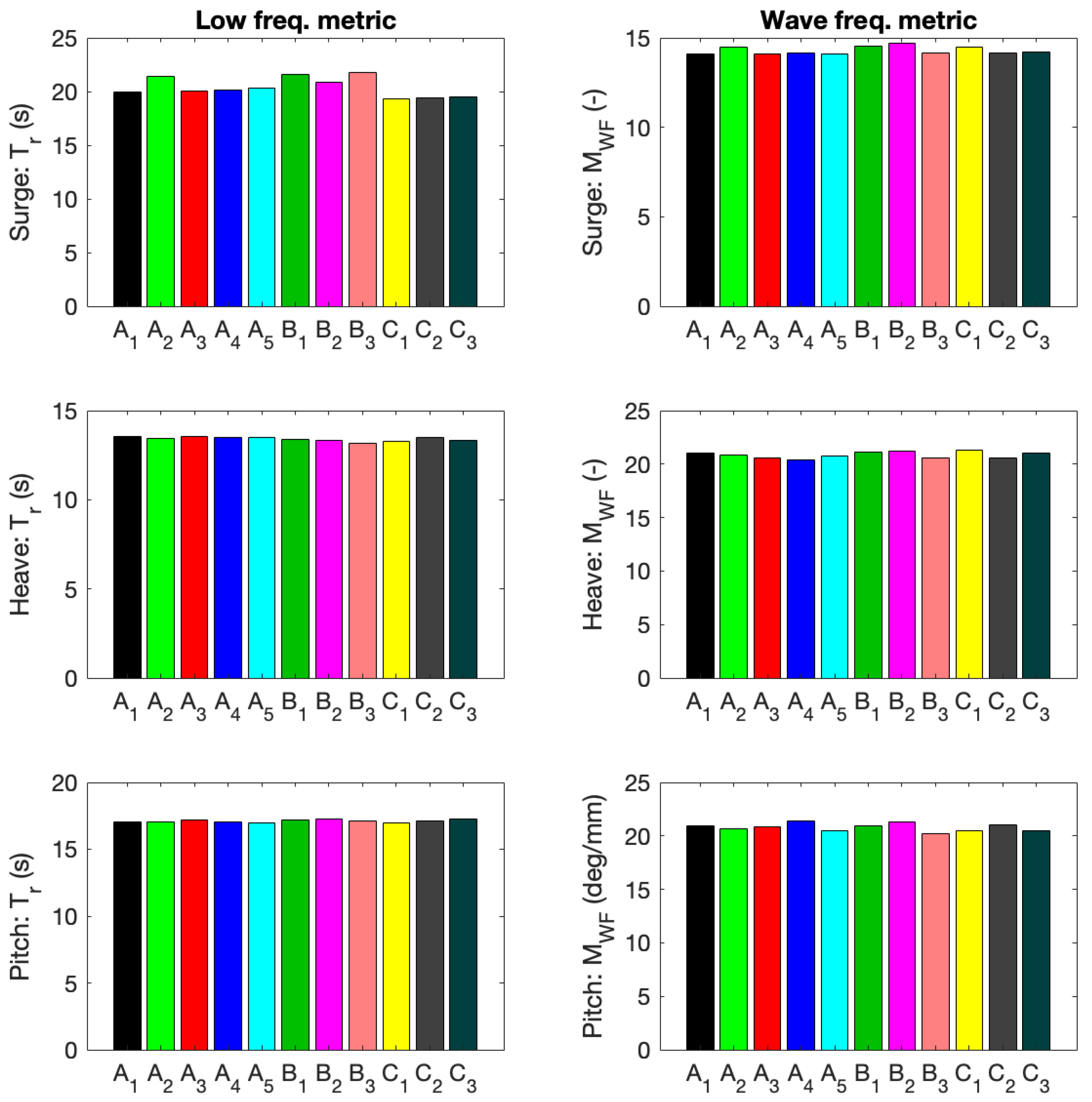
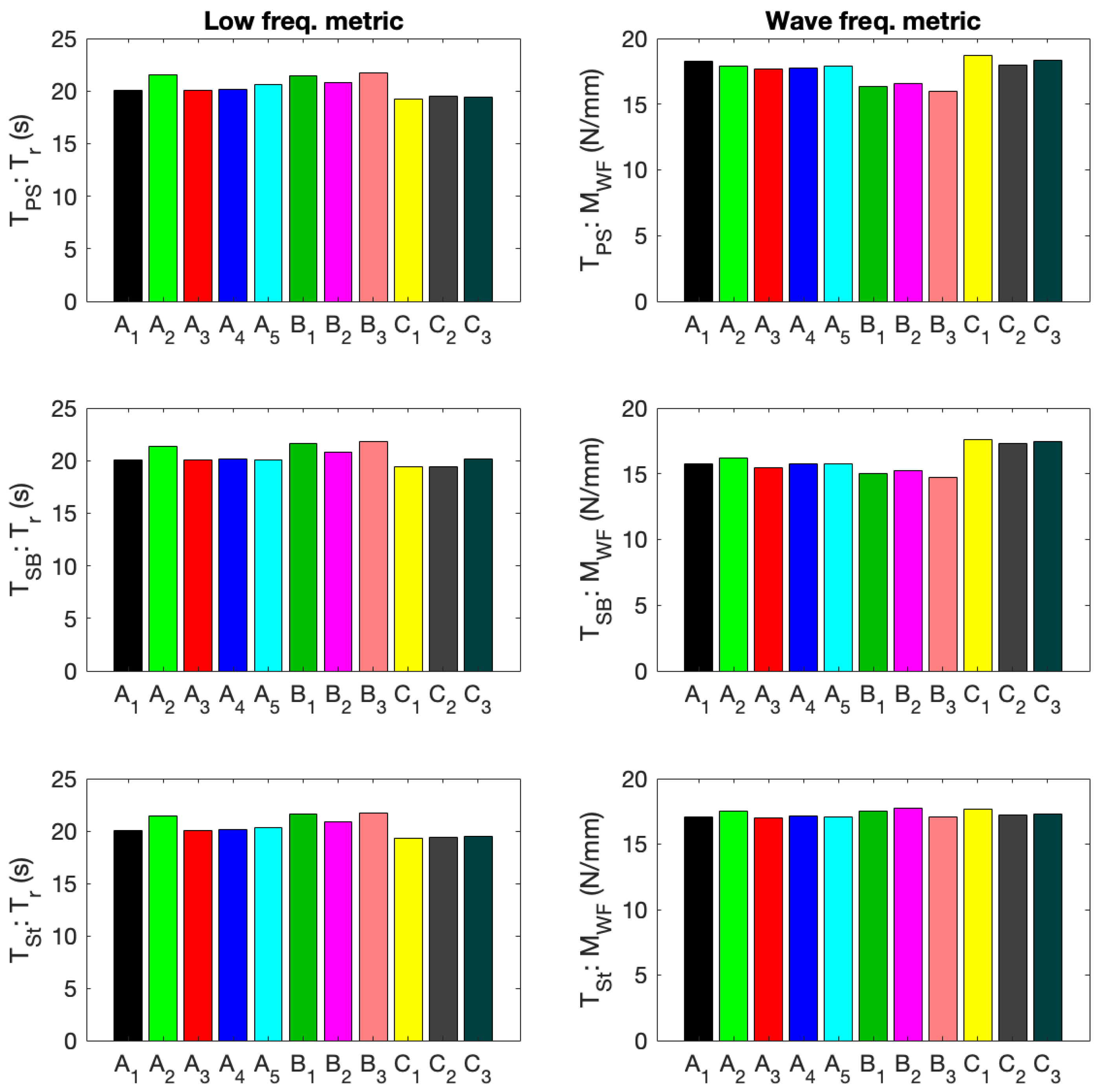








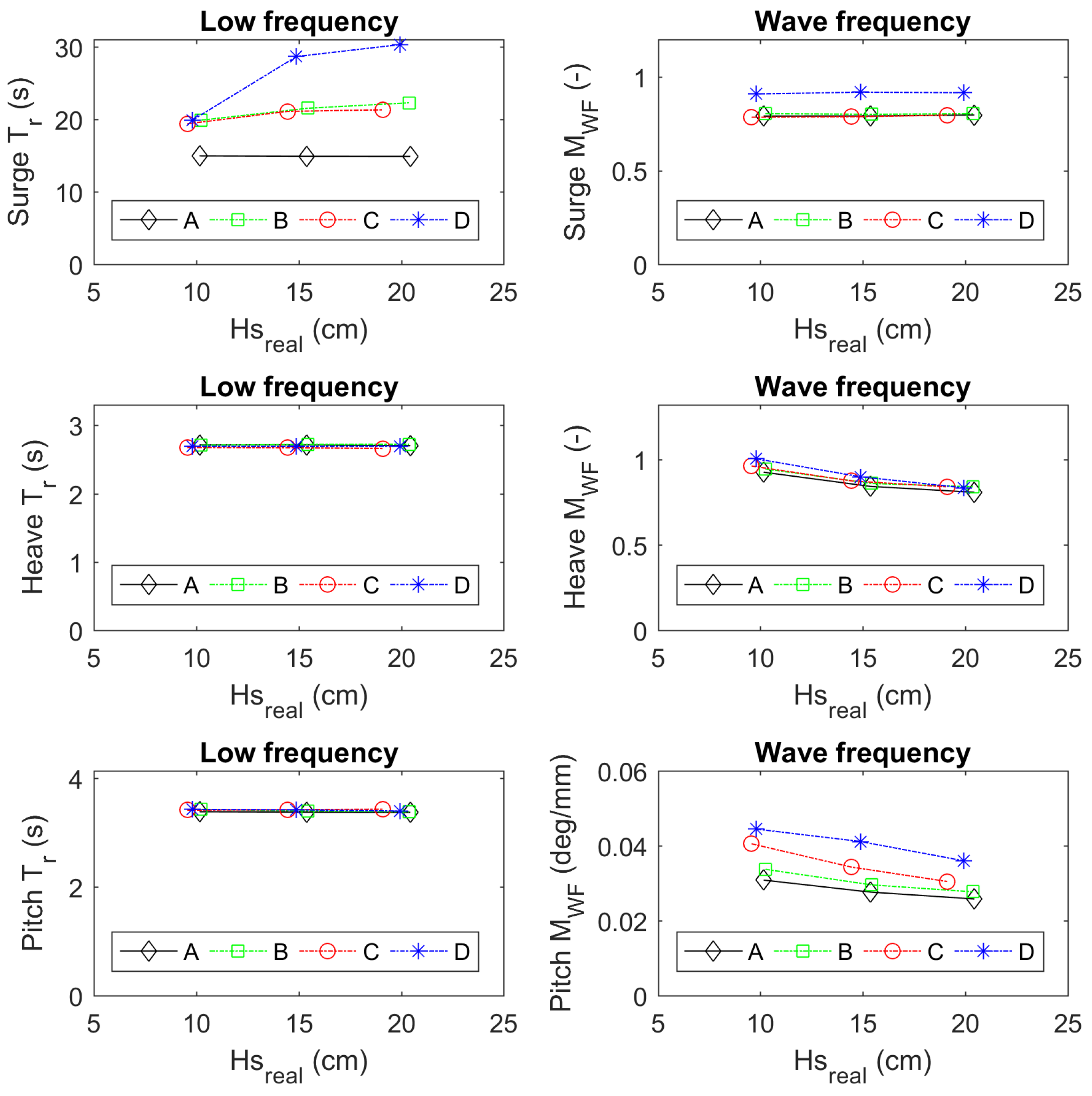

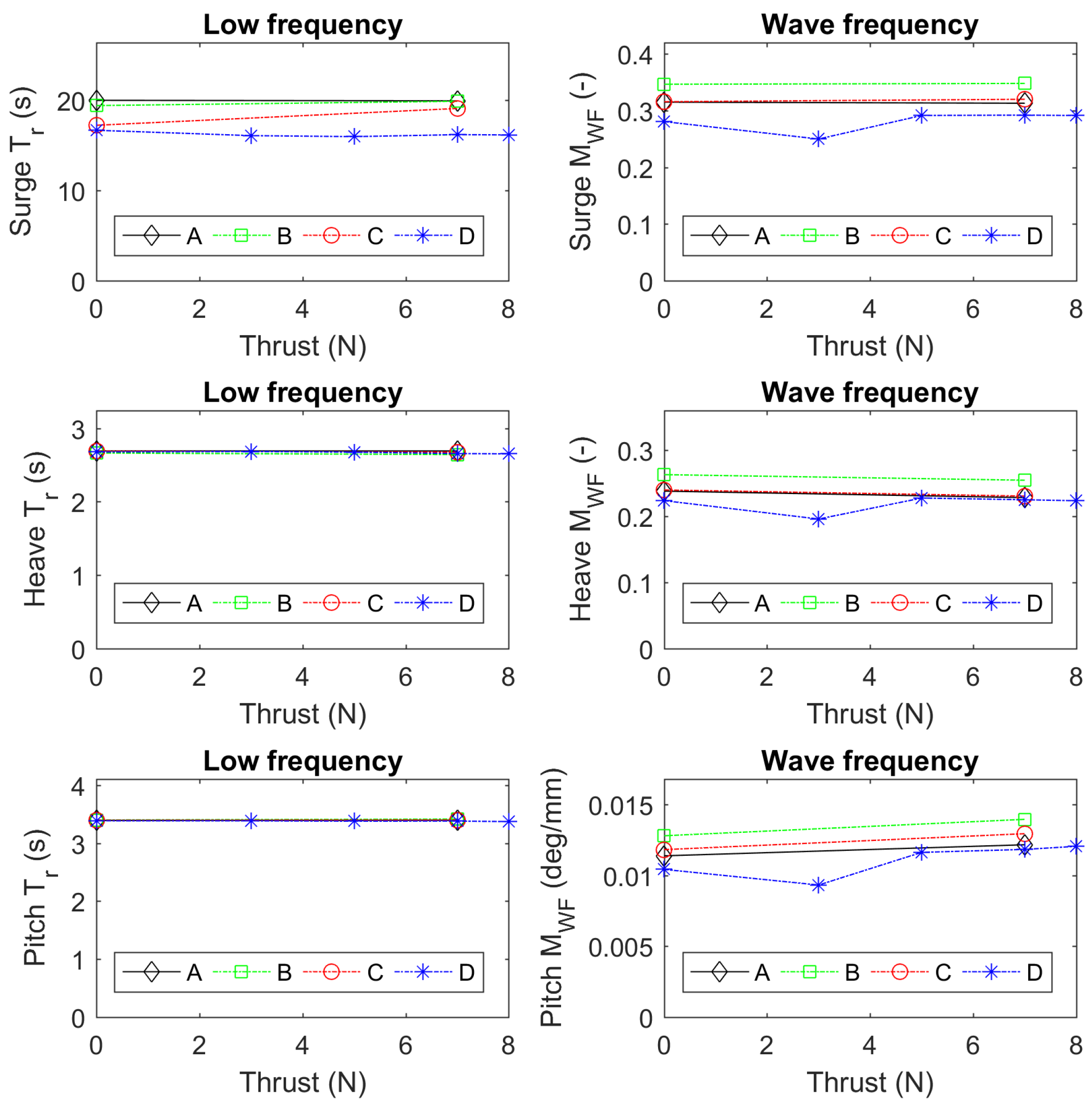

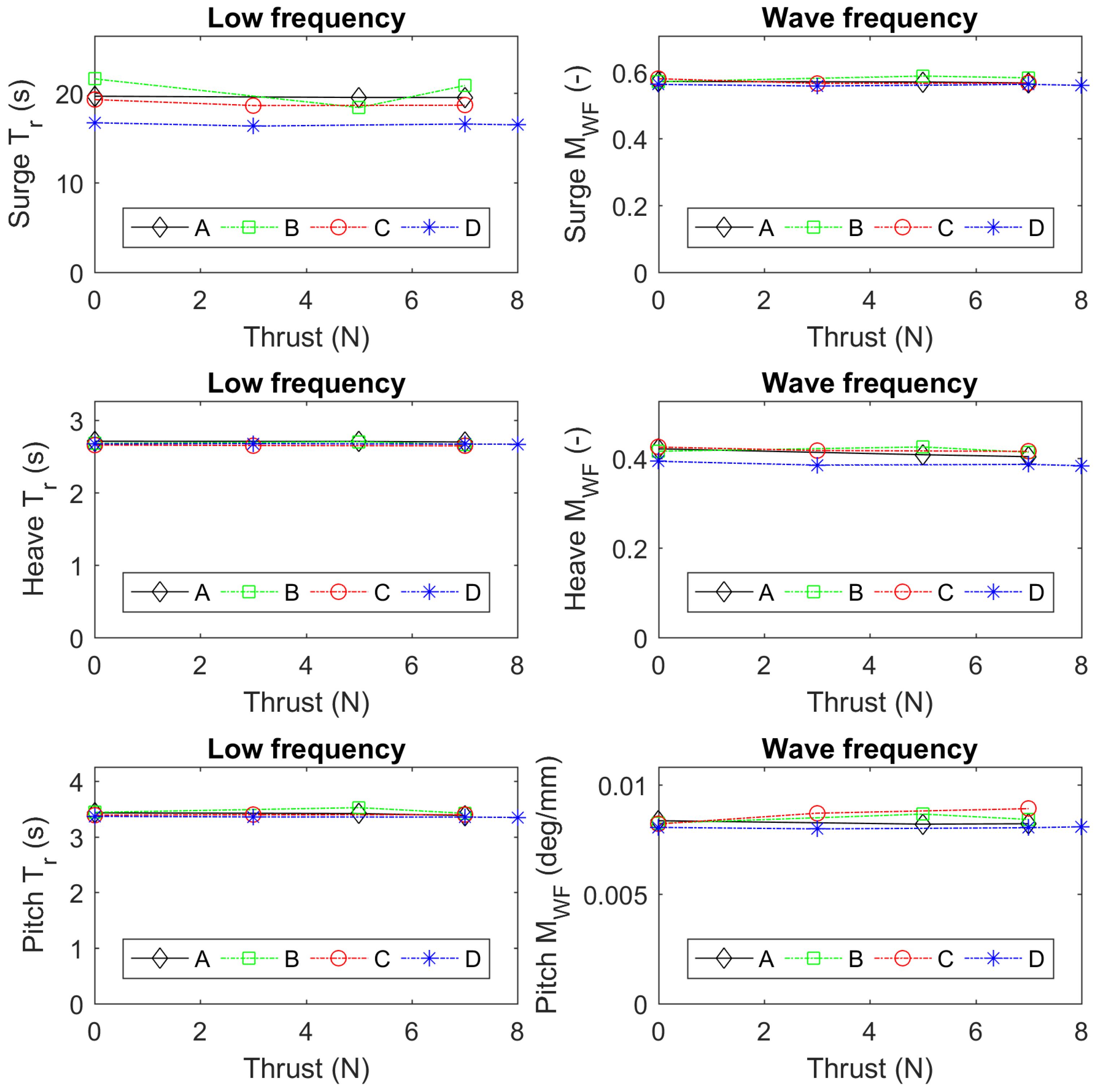

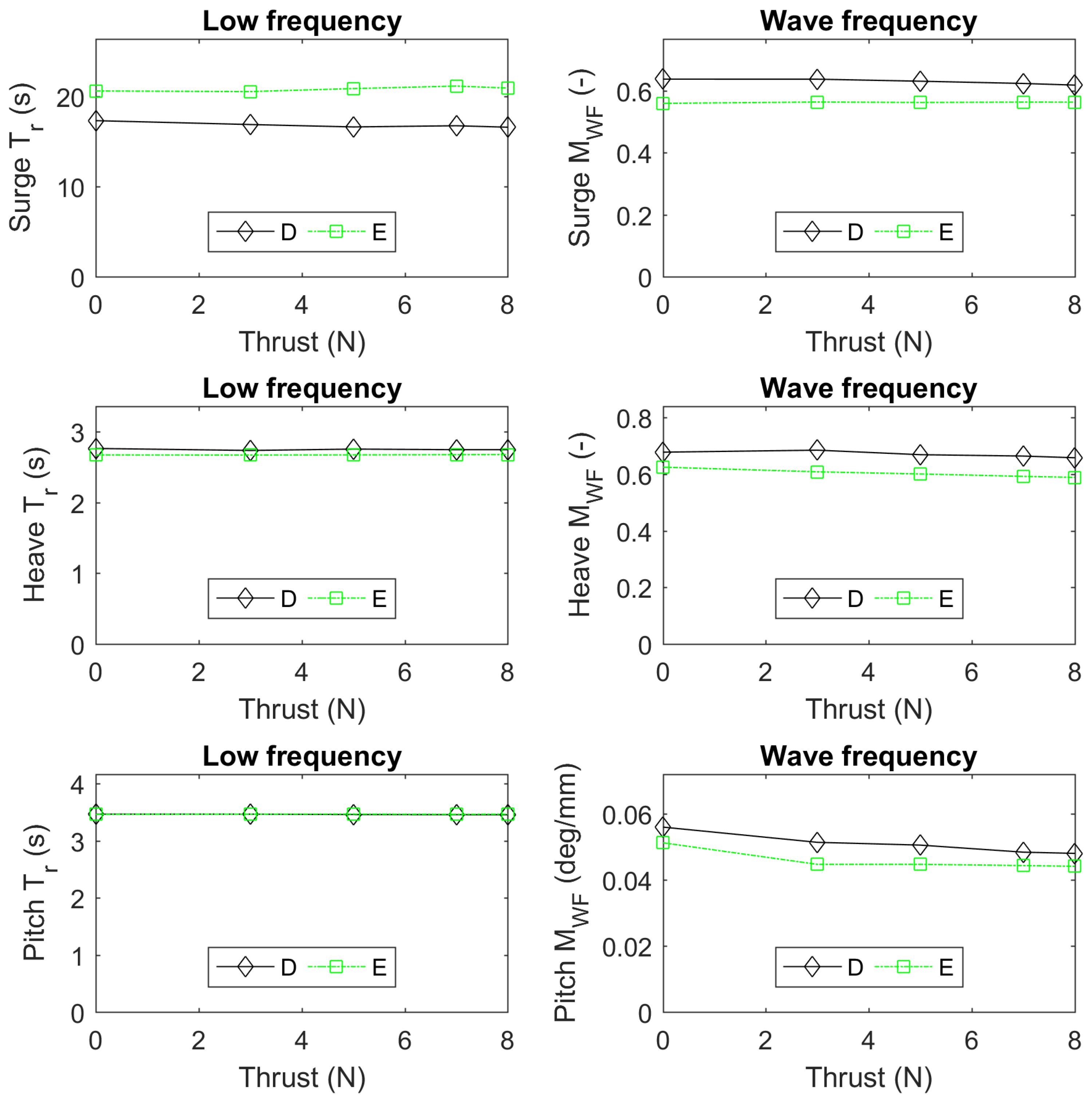
| Facility | Reference |
|---|---|
| ECN | A |
| Ifremer | B |
| UCC Campaign 1 | C |
| UoS | D |
| UCC Campaign 2 | E |
| Spectrum Details | (s) | (m) | Wind Thrust (N) | Details |
|---|---|---|---|---|
| JONSWAP () | 1.29 | 0.05 | 0; 5; 7 | A, B, C, D |
| JONSWAP () | 1.29 | 0.05 | 3; 8 | D |
| JONSWAP () | 1.29 | 0.075 | 0; 7 | A, B, C, D |
| JONSWAP () | 1.29 | 0.075 | 3; 5; 8 | D |
| JONSWAP () | 1.81 | 0.10 | 0; 7 | A, B, C, D |
| JONSWAP () | 1.81 | 0.10 | 5 | A, B, D |
| JONSWAP () | 1.81 | 0.10 | 3 | C |
| JONSWAP () | 1.81 | 0.10 | 3; 8 | D |
| JONSWAP () | 1.81 | 0.15 | 0; 7 | A, B, C, D |
| JONSWAP () | 1.81 | 0.15 | 5 | A, B, D |
| JONSWAP () | 1.81 | 0.15 | 3 | C |
| JONSWAP () | 1.81 | 0.15 | 3; 8 | D |
| JONSWAP () | 2.58 | 0.10 | 0 | A, B, C, D |
| JONSWAP () | 2.58 | 0.10 | 3; 5; 7; 8 | D |
| JONSWAP () | 2.58 | 0.15 | 0 | A, B, C, D |
| JONSWAP () | 2.58 | 0.15 | 3; 5; 7; 8 | D |
| JONSWAP () | 2.58 | 0.20 | 0 | A, B, C, D |
| JONSWAP () | 2.58 | 0.20 | 3; 5; 7; 8 | D |
| Pink noise | 0; 3; 5; 7; 8 | D, E |
| Motion Mode | Surge | Heave | Pitch | ||
|---|---|---|---|---|---|
| JONSWAP s | LF | LF | LF | 0.50 | 1.3 |
| JONSWAP s | LF | WF | LF | 0.35 | 1.2 |
| JONSWAP s | LF | WF | WF | 0.25 | 1.2 |
| Pink-Noise | LF | WF | WF | 0.25 | 1.2 |
| (Max-Min)/Mean (%) | A | B | C | A + B + C |
|---|---|---|---|---|
| Hs | 4.0 | 9.0 | 2.2 | 26.3 |
| 1.0 | 2.1 | 1.4 | 3.6 | |
| Surge | 7.0 | 4.3 | 0.9 | 12.1 |
| Heave | 1.0 | 1.7 | 1.4 | 2.8 |
| Pitch | 1.2 | 0.6 | 1.9 | 1.9 |
| Tension PS line | 7.6 | 4.1 | 1.3 | 12.2 |
| Tension SB line | 6.4 | 4.4 | 3.8 | 11.4 |
| Tension Stern line | 7.1 | 4.3 | 1.1 | 12.1 |
| Surge | 2.5 | 3.6 | 2.4 | 4.1 |
| Heave | 3.0 | 3.2 | 3.5 | 4.3 |
| Pitch | 4.3 | 5.6 | 2.8 | 6.1 |
| Tension PS line | 3.6 | 3.3 | 3.8 | 15.3 |
| Tension SB line | 4.5 | 3.7 | 1.7 | 17.8 |
| Tension Stern line | 3.1 | 3.7 | 2.3 | 4.1 |
Publisher’s Note: MDPI stays neutral with regard to jurisdictional claims in published maps and institutional affiliations. |
© 2021 by the authors. Licensee MDPI, Basel, Switzerland. This article is an open access article distributed under the terms and conditions of the Creative Commons Attribution (CC BY) license (https://creativecommons.org/licenses/by/4.0/).
Share and Cite
Gueydon, S.; Judge, F.; Lyden, E.; O’Shea, M.; Thiebaut, F.; Le Boulluec, M.; Caverne, J.; Ohana, J.; Bouscasse, B.; Kim, S.; et al. A Heuristic Approach for Inter-Facility Comparison of Results from Round Robin Testing of a Floating Wind Turbine in Irregular Waves. J. Mar. Sci. Eng. 2021, 9, 1030. https://doi.org/10.3390/jmse9091030
Gueydon S, Judge F, Lyden E, O’Shea M, Thiebaut F, Le Boulluec M, Caverne J, Ohana J, Bouscasse B, Kim S, et al. A Heuristic Approach for Inter-Facility Comparison of Results from Round Robin Testing of a Floating Wind Turbine in Irregular Waves. Journal of Marine Science and Engineering. 2021; 9(9):1030. https://doi.org/10.3390/jmse9091030
Chicago/Turabian StyleGueydon, Sebastien, Frances Judge, Eoin Lyden, Michael O’Shea, Florent Thiebaut, Marc Le Boulluec, Julien Caverne, Jérémy Ohana, Benjamin Bouscasse, Shinwoong Kim, and et al. 2021. "A Heuristic Approach for Inter-Facility Comparison of Results from Round Robin Testing of a Floating Wind Turbine in Irregular Waves" Journal of Marine Science and Engineering 9, no. 9: 1030. https://doi.org/10.3390/jmse9091030
APA StyleGueydon, S., Judge, F., Lyden, E., O’Shea, M., Thiebaut, F., Le Boulluec, M., Caverne, J., Ohana, J., Bouscasse, B., Kim, S., Day, S., Dai, S., & Murphy, J. (2021). A Heuristic Approach for Inter-Facility Comparison of Results from Round Robin Testing of a Floating Wind Turbine in Irregular Waves. Journal of Marine Science and Engineering, 9(9), 1030. https://doi.org/10.3390/jmse9091030







